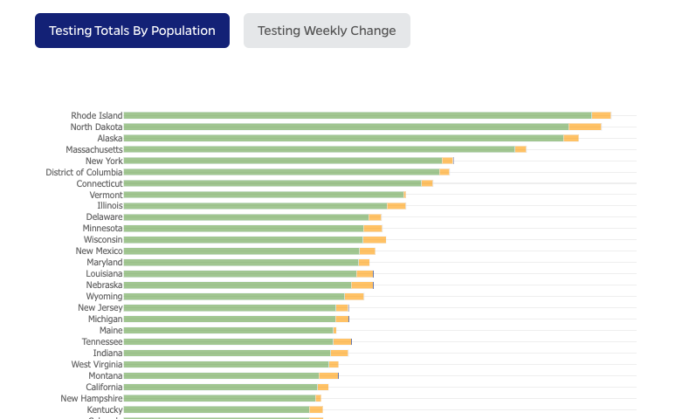The headlines shocked locals this week: the smallest state in the country, news sources stated, has the highest rate of COVID-19 infections in the world.
Several articles proclaimed the dire news, leaving many to speculate why Rhode Island seems to be losing its fight against the global pandemic. The infection rate of 122.6 for every 100,000 was compared only with countries such at Serbia and The Republic of Georgia in terms of positivity.
But the headlines didn’t tell the whole story.
According to data from the COVID Tracking Project compiled by Johns Hopkins University of Medicine, the state is also among the highest in the nation on testing.
In fact, Little Rhody nearly leads the way in testing in the U.S. by percent of population, beaten only by Alaska. The smallest state has administered 1,440.2 tests for every 100,000, people, according to the latest data.
Alaska has tested 1462.9. people for every 100,000 and Massachusetts, where recent news headlines have also referenced a massive spread, comes in third, with 1274.3 tests per 100,000.
By comparison, on the surface, the state of Iowa may appear to have a relatively low infection rate, with data updated on Thursday, Dec. 10 showing 73.72 new cases for every 100,000 people.
But a deeper dive into the data show the state has only administered 133.4 tests for every 100,000 residents.
“Positivity rates are a measure of testing capacity, and can help gauge whether governments are casting a wide enough net with their testing programs to identify infections that may be occurring,” an explanation of the data from Johns Hopkins explains. “While this metric can provide important context about case totals and trends, it is not a measure of how prevalent the virus is in communities.”
In essence, prevalence of the virus can only be discovered by comparing Rhode Island to regions with similar testing rates.
As such, both Massachusetts and Alaska rate high, with 86.54 and 80.79 new cases for every 100,000 people, as of the latest data.
“Policy decisions, like openings and closings or interstate travel, should not be determined based on test positivity alone,” the write-up on the data states. “Considering confirmed new cases, testing rates, and percent positivity together gives us a fuller picture of COVID-19 in a particular state or region.”
New test sites have launched in the state in recent weeks, and in her press briefing on Thursday, Dec. 10 Gov. Gina Raimondo said that by next week, the state aims to administer 5,000 test per day at just a single location.
Tests are free in the state and can be quickly scheduled online by visiting portal.ri.gov.
With that increased testing, the state will likely see a corresponding increase in known cases.
When looked at alone, the state’s positivity rate is somewhat misleading, but that’s not to say that Rhode Island’s high rates are not cause for concern.
Rhode Island has seen 1,498 deaths from COVID-19 since the start of the virus according to statewide data, and the number of cases continues to rise.
Locally, 664 people have tested positive in Burrillville and 504 in North Smithfield, with 35 percent and 37 percent of the population tested, respectively.
And nursing homes, where the virus poses a more serious threat to vulnerable populations, continue to see spread.
NRI NOW reported last week that 45-49 cases had been discovered at Overlook Nursing and Rehab Center in Pascoag over the previous two weeks, and the number has nearly doubled as of the latest update, with the nursing home reporting 70-74 cases in the past 14 days.
But those looking to understand the spread may want to look at the broader picture before declaring Rhode Island the epicenter of the COVID-19 pandemic.







